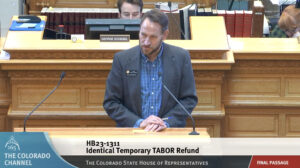Some 2,000 facilities across Colorado soon must report the amount of 482 different toxic air contaminants that they emitted in 2023 — an arduous process that is likely to lead to ramped- up regulations on five of what the state considers to be the most dangerous compounds.
This requirement stems from House Bill 22-1244, which was pushed by a coalition of neighborhood and environmental groups wanting the state to take a more active role in protecting residents from pollutants that could cause everything from cancer to birth defects. Unlike Colorado’s efforts to monitor and reduce ozone pollution, which focus on regional calculations, the monitoring of toxic air contaminants has an intensely local focus that is likely to lead to restrictions on specific compounds coming from an oil refinery or manufacturing facility, said Rep. Chris deGruy Kennedy, the Lakewood Democrat who co-sponsored the bill.
But to know if there is too much benzene coming from the Suncor Energy facility in Commerce City or too much ethylene oxide coming from the Terumo Corp. plant in Lakewood, the state must have data showing what is being emitted where and at what levels. And to do that, it will rely on a combination of existing data, newly self-reported data and figures from seven monitoring stations that are in the process of going up.
No small tracking requirement
For facilities ranging from oil/gas wells to utility plants to food manufacturers, this means they must track a wide range of contaminants coming from plants — a range much more extensive than the 187 contaminants which the U.S. Environmental Protection Agency monitors. While the list includes commonly tracked contaminants, it also includes some pesticides that are banned in the United States, nerve agents like sarin gas and even chemicals found in a can of WD-40, said American Petroleum Institute Colorado Associate Director Mike Paules.

Mike Paules is associate director of American Petroleum Institute Colorado.
And therein lies the biggest area of concern for business leaders — the amount of work they must do to track solvents as well as combustion, fugitive and process emissions, particularly because they are required to report even de minimis levels of contaminants. The newly stood-up Air Toxics Regulation Unit of the Colorado Air Pollution Control Division won’t even have the reporting templates available until February, so companies must track emissions before they even know how to report them and then get that information into the state by June 30.
Paules noted that the division has helped the process for oil and gas companies — expected to represent 58% of reporters, according to APCD data — by allowing them to report already regulated pollutants via the existing Oil and Natural Gas Annual Emissions Inventory Report. But for many other facilities, they are starting from scratch in tracking and reporting emissions without any indication of how those reports will be considering in rulemaking scheduled for 2025, he said.
“It really shows you the people who wrote this bill are not practitioners,” Paules said. “They just feel like we need to look for everything everywhere all the time.”
Reasons for the toxic air contaminants monitoring
DeGruy Kennedy acknowledged that consideration of final regulations likely will focus on about 60 different contaminants that are most dangerous to the health of the residents living near the facilities where they are emitted, and he said he’s open to streamlining the reporting process. But he said the state needs the extensive data to figure out what is coming out of which plants, and he’s focused his energy so far on ensuring good locations for the monitoring stations, which will be going near Suncor, near Weld County oil and gas wells and, he hopes, near Terumo.

Colorado state Rep. Chris deGruy Kennedy speaks on the Colorado House floor earlier this year.
“The goal is to identify places where pollutants are causing real health impacts. This isn’t about shutting down facilities,” he said while praising Terumo — located just outside his district — for the work it’s done to cut emissions, even as he suggested more could be done. “Air toxics are all local. It’s all about the local impact.”
Many of the companies that must report their contaminant levels already are doing so. Reporting requirements apply to any facility that already must obtain an operating permit from air-quality regulators, as well as those with incinerators subject to government regulation, synthetic minor sources and major sources of hazardous air pollutants.
Details of the new requirements
Contaminants that must be reported include the 358 non-criteria pollutants currently included in Air Pollution Emission Notice requirements, individual compounds like cyanide compounds that are part of a larger pollutant group, cooking-related or tobacco smoke compounds and chemicals used primarily as medicines or research for cancer and transplant treatments. Tracking all of them will be “time-sensitive,” Colorado Chamber of Commerce Air Quality Subcommittee Co-Chair Shannon Pollmiller said, though she added she’s glad facilities can report via EPA-approved emissions factors rather than smokestack testing only.
After the APCD receives and studies its first year of data, it is set to finish rulemaking by April 2025 on whether new controls must be added on certain contaminants, and it’s allowed under HB 1244 to put forward rules on as many as five of those contaminants.
In many ways, the burden falling on emitters is not so much that of this one rule but the combined effect of all the new air-quality regulations, Pollmiller said. Those include recently approved rules to limit emissions from large manufacturing facilities and from facilities located in disproportionately impacted communities.
“I do think it’s going to be doable, but it may be a little time-consuming,” Pollmiller said. “It would really be beneficial if (state regulators) put together some kind of instructions or guidelines on how to report.”
